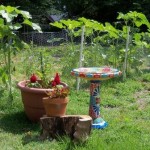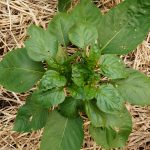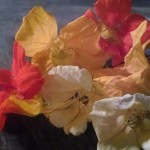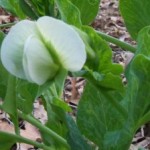By Tiffany Selvey, Master Gardener and mama of 1
You might have seen a post going around facebook that has a photo with a list of fruits, veggies and nuts stating, “If you like these foods, save the bees!”. While I don’t believe that the end of squash as we know it is ending, I do know that there are some very real effects from the drop in numbers of our best pollinator, the bee.
I have personally experienced the effects of insufficient pollination. Pollinators, including butterflies, bees, flies, even wasps, move pollen as they go from bloom to bloom feeding on nectar. They pick up pollen from male blooms and drop it off on sticky female blooms. Bees move a tremendous amount of pollen, obvious to anyone simply by looking at the yellow rings of pollen on their back legs. When a female bloom does not get pollinated, the fruit will not develop. This is why bees are so important.
If you have little ones in the home, it may not be feasible to have a lot of bee-attracting flowers near the entrance and exit of your home, but you can still do your part to help the pollinators.
Plant a wildflower bed in the corner of your yard: Most of us have an unused portion of yard we are tired of mowing. Why not turn it into a perennial — varieties that return every year without replanting — flower garden? There are many beautiful wildflowers that are great for attracting hummingbirds, butterflies and bees. Consider planting bee balm, dill, coneflower, zinnias, perennial sunflowers and dahlias for fresh blooms all season. Many of these varieties also make beautiful cut flowers.
Make seed bombs: Turn feeding the bees into a family event by making seed bombs. Soak newspaper in water until it is mushy fiber. Remove the fiber, take a pinch of wildflower seeds (I like these from Grow Organic), mix it up, and squeeze out the water. Allow it to dry thoroughly. Enjoy a cool afternoon drive with the family, tossing out your seed bombs. This is an excellent opportunity to discuss the science behind flowers and pollinators. Need a reminder? Pin instructions here.
Consider clover: Do you have any areas in your lawn where grass won’t grow? Try planting clover for a no-mow alternative. Dutch white clover grows to about 8” tall and produces tiny white blooms great for feeding all pollinators! Clover doesn’t tolerate much traffic, so plant it in those areas that are infrequently traveled.
Tiffany Selvey is a Master Gardener who writes about her passion for growing, cooking, and living naturally at www.Songbird-Gardens.com. When she’s not elbow deep in soil, she enjoys raising a very active son, laughing with her husband, and wrangling their pets. Follow Tiffany’s gardening adventures on facebookand on twitter.





